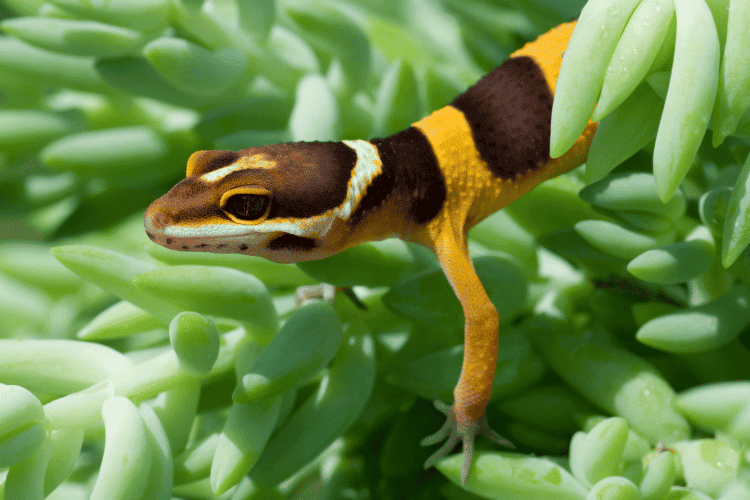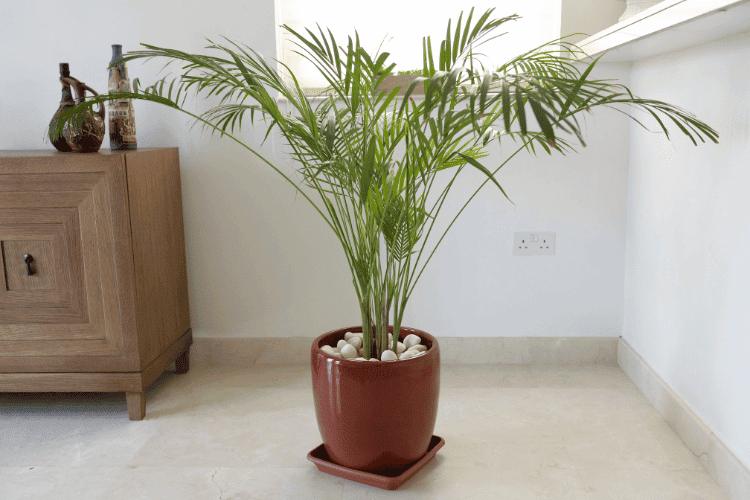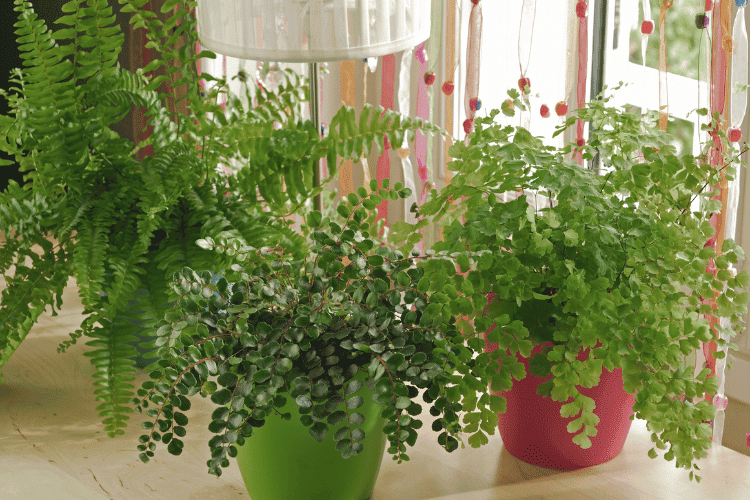While artificial plants have their place, the introduction of real plants within your gecko’s enclosure offers a distinct advantage: the opportunity to greatly enhance its quality of life.

The authenticity and vitality of real plants bring a touch of nature that synthetic alternatives simply can’t replicate. They offer hideouts, climbing opportunities, and a sense of security that helps your gecko feel more at home.
But here’s the catch: not all plants are safe for our scaly buddies. Imagine munching on something that looks tasty but ends up being a total no-go for your taste buds—not a fun experience, right? The same goes for geckos.
In this article, we’ll explore a range of safe plant options that contribute to the overall health and happiness of your scaly companions.
1. Spider Plant
Starting our list is the Spider Plant, a popular choice for indoor environments due to its aesthetic appeal and air-purifying abilities.
Its cascading leaves lend a touch of elegance to an enclosure, while its ability to filter air enhances the habitat’s overall atmosphere.
Spider Plants are non-toxic to geckos, making them an excellent choice for creating a visually appealing and safe space. They typically grow to be around one to two feet tall and have a spread of about two to three feet.
2. Snake Plant
The Snake Plant, known for its robust nature and minimal care requirements, is another safe option for gecko enclosures. The plant’s upright growth and varied leaf patterns bring an element of sophistication to the habitat.
Snake Plants are well-suited for lower light conditions, making them suitable for indoor setups. Their non-toxic properties provide peace of mind to gecko owners.
3. Pothos
Pothos, also referred to as Devil’s Ivy, offers a versatile addition to gecko enclosures. Its trailing vines can serve as climbing opportunities, adding an element of vertical exploration for geckos.
Additionally, the dense foliage of Pothos provides excellent hiding spots for these creatures. This plant’s low-maintenance requirements and gecko-friendly nature make it a favored choice among reptile enthusiasts.
4. Haworthia
For gecko owners looking to emulate arid environments, Haworthia plants offer an attractive solution.
These tiny succulents possess distinctive rosette patterns, adding visual interest to enclosures while creating a desert-like ambiance.
The spiky structures of Haworthias provide both visual appeal and safe refuge for geckos.
5. Aloe Vera
Aloe Vera, famous for its soothing gel, serves a practical purpose beyond its decorative appeal.
This plant’s presence introduces a touch of greenery while providing a valuable resource for potential first aid. Should your gecko experience minor skin irritations or have difficulties shedding, the gel can offer relief.
While Aloe Vera is generally considered safe for geckos, it’s essential to monitor their behavior around the plant.
Some geckos might be curious and attempt to nibble on the leaves. Ingesting large quantities can cause gastrointestinal upset. To prevent excessive nibbling, ensure your geckos have other safe and appealing items in their enclosure, like food, fresh water, and hiding spots.
6. Jade Plant
Characterized by its thick, fleshy leaves and streamlined appearance, the Jade Plant, also known as the Money Plant, brings a minimalistic elegance to reptile enclosures.
Its hardy nature and non-toxic properties make it a suitable choice for gecko habitats, adding a touch of refinement to their environment.
7. Succulent Sedums
Succulent Sedums are hardy plants that offer a broad range of foliage options, contributing to the visual diversity of gecko enclosures. Their varied shapes, colors, and textures can be selected to suit the aesthetics of the habitat while maintaining gecko safety.
Here are a few examples of succulent sedums that you might consider for your gecko enclosure:
- Burro’s Tail
- Jellybean Plant
- Coppertone Stonecrop
- Gold Moss Stonecrop
- Golden Sedum
8. African Violet
With their dainty blooms in shades of purple, pink, and white, these plants add a touch of elegance to your gecko enclosure.
Their unique shapes and vibrant colors create a visually appealing natural environment that not only benefits your geckos but also enhances the overall aesthetic of the habitat.
African violets are compact and manageable, making them a charming addition to any enclosure.
9. Bamboo Palm
Bamboo palms create that paradise-like atmosphere for your geckos, bringing a sense of relaxation and lushness to the habitat.
Their non-toxic leaves provide both aesthetics and comfort, giving your geckos a spot to lounge beneath the swaying fronds.
The fronds and branches can also serve as hiding spots, creating nooks where your gecko can retreat to when they want privacy or a break from the light.
In terms of care, Bamboo plants are relatively low-maintenance. They thrive in indirect light and moderate humidity levels, which are conditions that can often be easily maintained in a gecko enclosure.
Just make sure not to overwater them, as they prefer to dry out between waterings.

10. Echeveria
Echeverias are succulent plants known for their captivating hues and unique rosette formations. Their striking appearance introduces vibrant colors and intricate patterns to gecko habitats.
While Echeverias require careful monitoring to prevent overconsumption, their non-toxic nature ensures a safe interaction with your geckos.
11. Calathea
If you’re seeking plants with captivating leaf patterns, Calatheas won’t disappoint.
These plants showcase an array of intricate designs, creating a visually dynamic environment.
Beyond their aesthetic appeal, Calatheas contribute to the overall humidity of the habitat, benefiting your geckos’ well-being.
12. Begonia
Begonias come in a plethora of varieties, each with its unique leaf shape, color, and pattern.
This diversity makes them an excellent choice for adding visual interest to your gecko’s natural habitat.
From their striking foliage to their ability to adapt to different light conditions, begonias are versatile companions.
13. Nerve Plant
For geckos in tropical setups, Fittonias, or nerve plants, are a perfect match. Their vibrant veined leaves not only offer a stunning visual display but also thrive in humid environments.
Adding a splash of color and texture, Fittonias contribute to the habitat’s overall aesthetics.
14. Lipstick Plant
Let’s elevate the habitat vertically with Lipstick Plants. These hanging wonders grace the enclosure with cascading vines and tubular flowers that resemble lipstick tubes.
Suspended from branches or structures, they provide both a unique aesthetic and an additional layer of exploration for your curious geckos.
15. Bromeliads
Bringing a touch of the tropics to your gecko’s world, bromeliads are a fantastic addition.
These plants boast a variety of colors and shapes, making them both visually appealing and functional. The central rosette of bromeliads provides a perfect hiding spot for your geckos to retreat to when they need some privacy.
The following bromeliads are suitable for gecko enclosures:
- Neoregalia bromeliads
- Tillandsias
- Silver Vase Bromeliad
- Earth Stars
- Guzmania bromeliads
- Blushing Bromeliad
16. Baby Tears
For those who appreciate a lush and cozy ground cover, Baby Tears is an excellent choice.
The tiny, rounded leaves create a soft, carpet-like texture that adds comfort to your gecko’s enclosure.
This plant contributes to the overall ambiance of the habitat while offering a naturalistic feel.
17. Prayer Plant
The Prayer Plant is a mesmerizing addition to your gecko’s environment.
Its leaves fold up at night, resembling hands in prayer, and unfurl during the day.
This rhythmic movement adds a touch of fascination to the habitat while providing a safe and non-toxic foliage option.
18. Orchids
Orchids bring an air of sophistication to any space, including your gecko’s habitat. Their intricate and delicate blooms are a sight to behold, adding a classy vibe to the Leopard gecko enclosure.
To keep your orchids happy, give them some bright but not-too-direct light. Proper air circulation is essential to prevent moisture buildup and fungal issues.
If you want to up the humidity, a little mist around the orchid is cool, just make sure not to spray it right on the plant itself.
19. Rubber Plant
Rubber Plants are known for their adaptability and ease of care. With their glossy leaves and hardy nature, they can withstand various conditions while remaining non-toxic for geckos.
Rubber Plants tolerate a range of light conditions, from moderate to bright, indirect light. Allow the top inch of soil to dry before watering thoroughly. Maintain a well-draining potting mix and avoid overwatering to prevent root rot.
20. Boston Fern
For a splash of lush greenery, consider Boston Ferns. These plants have feathery fronds that bring a touch of the forest to your gecko’s habitat.
Boston Ferns thrive in humid environments and provide a visually appealing backdrop. Place them in bright, indirect light and water consistently to keep the soil evenly moist.
Mist the fern regularly to maintain humidity levels and prevent the fronds from drying out.

21. Coleus
Coleus plants are known for their vibrant and multicolored leaves, making them a lively addition to your Leo gecko’s world. With an array of patterns and shades, these plants contribute to a visually dynamic and safe environment.
Coleus plants thrive in bright, indirect light but can tolerate some dappled sunlight. Water consistently to keep the soil evenly moist, and provide well-draining soil to prevent waterlogging.
To encourage bushy growth, pinch back the stems periodically.
22. Peperomia
Peperomias come in various shapes and sizes, each with its unique leaf structure. These compact plants are easy to manage and add charm to a Leopard gecko tank of any size. Their non-toxic nature ensures a safe interaction with geckos.
23. Creeping Fig
For geckos that love to climb, the Creeping Fig provides an ideal vertical element. This trailing plant can be trained to climb on structures within the enclosure, creating a dynamic climbing space for geckos to explore.
Creeping Figs require bright, indirect light to thrive. Allow the top inch of soil to dry between waterings.
When using it as a climbing element, ensure it’s securely attached to structures within the enclosure. Regular pruning will help maintain its desired growth pattern.
24. Air Plants
Consider plants known for their air-purifying properties, such as Peace Lily and Areca Palm air plants. These plants not only contribute to the aesthetics of the habitat but also help maintain air quality.
For Peace Lilies, place them in low to moderate light conditions and water when the top inch of soil is dry.
Areca Palms thrive in bright, indirect light and prefer consistently moist soil.
These plants contribute to air quality but require regular monitoring of their water and light needs.
25. Haworthiopsis
With its geometric rosette formation, Haworthiopsis, formerly known as Haworthia Retusa, adds an artistic touch to your gecko’s enclosure.
Its striking symmetry and non-toxic nature make it an appealing choice for creating structured visual interest.
Haworthiopsis plants prefer bright, indirect light and well-draining soil. Due to their smaller size, they’re well-suited for smaller enclosures. Regularly monitor their water needs to prevent overwatering.
Tips for Introducing Plants to Leopard Geckos’ Habitat
- When setting up a Leo gecko’s habitat, taller tanks are a smart choice for creating vertical space that accommodates a wide variety of plants.
- A bioactive enclosure is an excellent option, housing a range of safe succulents, arid plants, and decorative favorites.
- Incorporating desert plants like rope plants or evergreen species such as Echeveria not only enhances the aesthetic but also provides an environment that mirrors a Leo gecko’s natural habitat.
- Consider mature and extremely long-lasting plants to ensure the longevity of the enclosure’s appeal.
- Consider introducing plants with vibrant and bright colors, such as those with a striking pink hue, to add visual interest to their habitat while catering to their natural instincts.
- For plants that require ample sunlight, consider incorporating UV light to provide the necessary light spectrum for their optimal growth.
Wrapping Up
To create the ideal environment for your leopard gecko, it’s essential to incorporate a reliable heat source like a heat mat that offers temperature gradients across the floor space.
Alongside this, introduce visually appealing and gecko-safe plants such as the beautiful pink Elephant Bush and the distinctive Ponytail Palms.
Consider varieties that thrive in arid conditions, require well-drained soil, and can tolerate direct sunlight for a certain number of hours each day.
With a variety of textures, colors, and growth patterns, you’ll create an environment that both nurtures your gecko’s well-being and provides you with a visually captivating miniature ecosystem.


